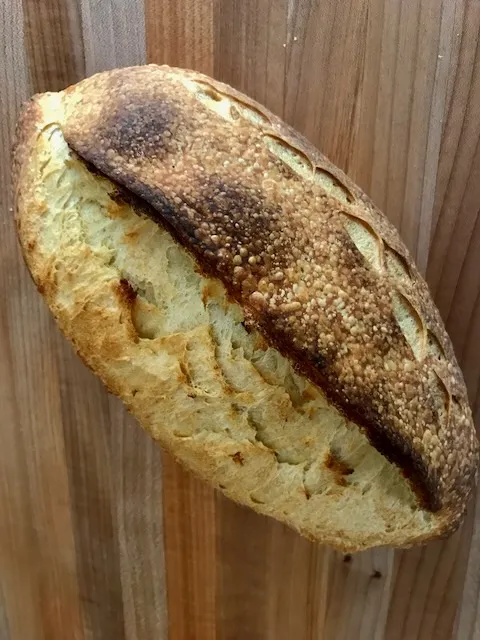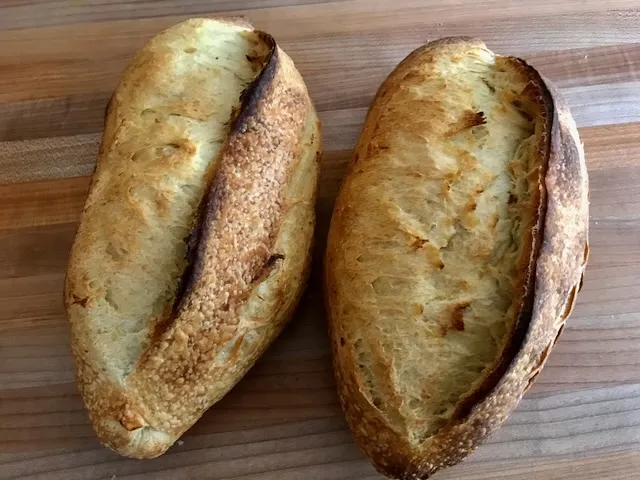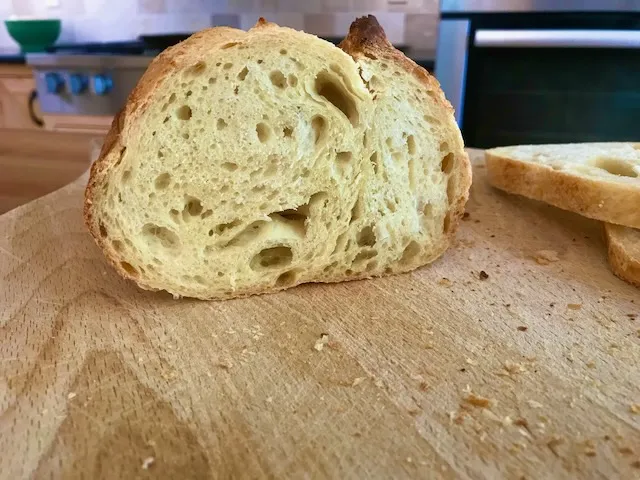
A few days ago, @pul posted some lovely pics of creamy, yellow semola loaves that reminded me of the community bake of a year or so ago and my good results from that exploration. ...which got me ruminating and scheming on following @pul's lead.
So down the rabbit hole of @dmsnyder's, @Franko's and @dabrownman's meanderings on Pane Tipo Altamura I dropped, deciding eventually to follow @pul's lead with a few modifications.
- Planned for 1.5 kg of 73% hydration dough to build 2 batards
- Prepared 220 g of 56% hydration biga per @pul
- Prepared 300 g of semola poolish (because it's what i do)
- 1 hour fermentolyze(?) incorporating biga, poolish, 900 g flour and 400 g (to get to 95%) of water
- Added remaining water and increased salt to 1.7%
- 3 (more?) hours of bulk with 4 stretch and folds
- 18 hour retard at 37º F
- Preshape with 30 minute rest, then final shape and 1 hour bench rest
- Bake with convection/steam 20 minutes at 450º, then convection only 18 minutes at 425º

A few observations of note:
- This semola biga showed quite a bit more growth than I expected. The flour really liked liquid though the dough seemed quite easy to work with.
- 100% hydration semola poolish, on the other hand, grew but less vigorously than my usual AP poolishes. Suspect that the gluten was just holding on tighter.
- Machine mixing the flour went well until the very end. I had to really work on getting the last 100+/- grams incorporated. Once again, gluten seemed quite tight though, visually, an absence of the stringy fibrous gluten matrix you see with white flours.
- The dough, on the other hand was very silky and nice to handle. I would hesitate to call it highly extensible, though, in the end, it was cooperative enough on shaping.
- Loaves seemed smallish before loading, but they really took off, exposing beautiful ears. I keep relearning that I tend to get better ears on lower hydration loaves like these.
- Thicker and crunchier crust then I was expecting. Lovely cream(?) colored crumb. Distinctly different and pleasant flavor

In conclusion, I'm not seeing a lot of reason to handle this dough a whole lot differently than I would for standard sourdough loaves. I think next time around, I'll try getting to 80% hydration with a normal 100% hydration levain as I do for my 50% semola ciabatta.
Thanks to @pul for the inspiration and TFL community (alfanso!) for a million insights.
- foodforthought's Blog
- Log in or register to post comments
What a great looking crumb. Would love to try something like that. I have some markets nearby with all kinds of different flours. I should check if they have the kind you are using,
Happy,
I've been using Caputo (a bit spendy as flour goes) 1 kg bags which I get from Nugget markets in the Sacramento region. @idaveindy has made a number of posts about Indian grocery alternatives. We have a number of good Indian grocers in these parts. My only hesitance has been that the quantities seem to be in the 20-50 pound range. 20 is proobably not out of the question for me, but then I don't particularly want the high bran versions, so maybe need to have deeper conversation with store staff. You should be able to find the Caputo flour at any good Italian grocery. I haven't been going through a ton of Semola in any event, even with frequently requested ciabatta, so 4-buck 1 kilo bags have been working for me as long as my grocer keeps stocking it.
Phil
Thanks or the followup I have Indian / Sri Lankan markets nearby and I'm sure I saw semolina/semola last time I was there. Need to go back and check for it now I know what to look for :)
"Rimacinata". Semolina won't be quite the same.
David at those sort of markets it will help to ask for fine sooji.
Thanks Jon! I think I may have seen that word. It's overwhelming whenever I go down the aisle with tons of different items with unfamiliar names. "sooji" helps a lot!
Very nice bake indeed! Now toast and dip into olive oil to really enjoy durum bread. Delicious.
Beautiful loaves with such a pretty crumb. Thanks for the reminder to bake with semola rimacinata again soon.
Benny
in its pure and a few bran-added and hybrid forms that I'be been able to bake with. The shaping and scoring are just so right.
alan
I love them. Wonderful. Well shaped and scored.
Phil, those loaves are really pretty and the golden color is so enticing. I have had great results with semolina rimacinata, not to mention its unmatched nutty flavor. Alfonso has been our champion in showing the virtues of this flour, and for that I am also thankful.
Pul
here on TFL. And here are a few semolina gems...
And the list gos on and on. But just for fun, here is a one of my personal favorites, cause it looks so cool,
my own Abel inspired Ziggy http://www.thefreshloaf.com/node/55676/abels-ziggy-sesame-semolina
Alan
Thank you. That being said, this semolina bake is maybe the best bread I have ever baked! I can't believe this bake is almost two years old.
Golden bread
Inspiring post actually, and good looking breads. Think I need to try and make one just like that, great reminder to add a pure semolina bread to my list of things to bake next. "Just like that" may be an exaggeration - those breads do look great and my previous attempts with semolina haven't been all that great, but will give this one some thought before trying.
What beautiful breads. Have not even come close to trying durum but these look delicious. I thought it might be interesting to OP and others that the latest post from Brotdoc involves his doing a study of 7 different varieties of durum, at the invitation of Prof. Friedrich Longin, who heads up the "Arbeitsgruppe Weizen" at the University of Hoheinheim in Germany. I really liked his design and his article, as I do all his posts. The included recipe, as he indicates, is straightforward, as this was meant to be a simple platform from which to study the different varieties.